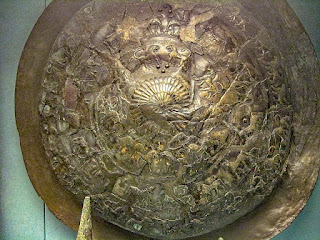This unusual vase shows a human head of which all but the area of the eyes, nose, and mouth is enclosed in the head of an animal. The softness of the pelt is indicated by the way in which it tightly fits the human head. The small ears and spots are further animal attributes. It is difficult to identify the figure. It may possibly be a very Egyptianized interpretation of Herakles wearing the lion skin. - Metropolitan Museum of Art
This vessel caught my attention because it reminded me very much of ancient pre-Columbian American art. All major Mesoamerican civilizations prominently featured a jaguar god, and for many, such as the Olmec, the jaguar was an important part of shamanism. The jaguar's formidable size, reputation as a predator, and its evolved capacities to survive in the jungle made it an animal to be revered. The Olmec and the Maya witnessed this animal's habits, adopting the jaguar as an authoritative and martial symbol, and incorporated the animal into their mythology.
In the surviving Olmec archaeological record, jaguars are rarely portrayed naturalistically, but rather with a combination of feline and human characteristics. These feline anthropomorphic figures may range from a human figure with slight jaguar characteristics to depictions of shamanistic transformations in the so-called transformative pose, kneeling with hands on knees, to figures that are nearly completely feline.
One of the most prominent, distinctive, and enigmatic Olmec designs to appear in the archaeological record has been the "were-jaguar". Seen not only in figurines, the motif also may be found carved into jade "votive axes" and celts, engraved onto various portable figurines of jade, and depicted on several "altars". The were-jaguar figure is characterized by a distinctive down-turned mouth with fleshy lips, and almond-shaped eyes.
The Maya, whose territory spanned the Yucatán Peninsula all the way to the Pacific coast of Guatemala, depicted gods with jaguar attributes as well. The jaguar is said to have the ability to cross between worlds, and for the Maya daytime and nighttime represented two different worlds. The living and the earth are associated with the day, and the spirit world and the ancestors are associated with the night. As the jaguar is quite at home in the nighttime, the jaguar is believed to be part of the underworld. Thus, Maya gods with jaguar attributes or garments are thought to have represented underworld gods. One such god is Xbalanque, one of the Maya Hero Twins who descended to the underworld, and whose entire body is covered with patches of jaguar skin. Another is God L, who is the primary lord of the underworld and often is shown with a jaguar ear or jaguar attire, and atop a jaguar throne.
This reverence for the jaguar carried forward to the much later Aztec civilization where their military elite were inducted into a unit dressed in jaguar regalia. To become a jaguar warrior, a member of the Aztec army had to capture a total of four enemies from battles. This was said to honor their gods in a way far greater than killing enemy soldiers on the battlefield. They also used spears and atlatls and fought with a wooden club studded with obsidian volcanic glass blades, called a macuahuitl.
Jaguars, of course, were not known in the ancient Mediterranean world but the First Dynasty Egyptian deity Mafdet was often depicted wearing the skin of a cheetah. She was associated with the protection of the king's chambers and other sacred places, and with protection against venomous animals, which were seen as transgressors against Maat. She also represented the personification of legal justice. It was said that Mafdet ripped out the hearts of wrong-doers, delivering them to the pharaoh's feet like cats that present humans with rodents or birds they have killed or maimed. During the New Kingdom, Mafdet was seen as ruling over the judgment hall in Duat where the enemies of the pharaoh were decapitated with Mafdet's claw.
During the reign of Tutankhamun, leopards were highly prized as symbols of royalty and divinity. A leopard skin mantle or a cloth imitation of one was worn by the high priest during the opening of the mouth ceremony at royal burials.
Although a panther is often referred to as an attribute of the god Dionysus, the god was also depicted wearing leopard skin and using leopards as a means of transportation. In one myth, the god was captured by pirates but two leopards appear and rescue him.
I find it interesting that cultures so far removed from each other wove their reverence for their respective spotted cats into their myths and religious practices. I can't help but wonder if the leopard-shrouded Greek figure of the 6th century BCE may have presided over one of the mystery religions as a similar priest in ancient America did.
 |
| Faience aryballos (oil flask) in the form of a head wearing an animal skin, 6th century B.C.E., East Greek, at the Metropolitan Museum of Art. |
 |
| An Aztec jaguar warrior created by GodotDraws on DeviantArt |
 |
| Aztec jaguar warriors based on codex illustrations created by American miniaturist George S. Stuart. Photograph by Peter D'Aprix. |
 |
| Aztec jaguar warriors based on codex illustrations created by American miniaturist George S. Stuart. Photograph by Peter D'Aprix. |


















































